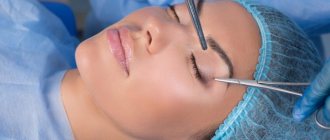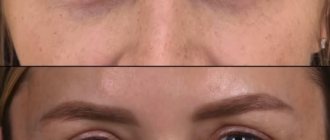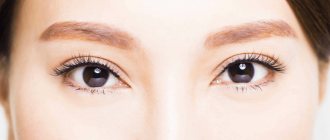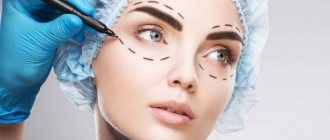Benefits of eyelid surgery
Blepharoplasty allows you to correct imperfections in the upper or lower eyelid, change the shape and even the shape of the eyes (canthoplasty). Why are clients increasingly choosing this method of plastic surgery:
- A pronounced aesthetic effect is the opportunity to acquire an open look, get rid of wrinkles, infraorbital hernias and generally look younger.
- The relative simplicity of the intervention - the operation is often performed under local anesthesia and takes no more than 1.5 hours.
- Short rehabilitation – after the intervention the patient does not need to stay in the hospital, and full recovery takes about 2 weeks.
- Affordability – today many people can afford the services of a plastic surgery clinic.
- Lasting effect - the result of blepharoplasty lasts for 7-10 years, after which the procedure can be repeated.
Blepharoplasty or eyelid surgery (from blepharon, in Greek - “eyelid”) is a plastic surgery to remove excess skin and fatty tissue from the upper or lower eyelid and, in some cases, strengthen their muscle tone. Thanks to blepharoplasty, you can get rid of bags and swelling under the eyes, some types of wrinkles, and also cope with such an unpleasant disease as ptosis (drooping of one or both upper eyelids). You can lift the corners of your eyes, eliminate asymmetry, and remove excess skin on the lower and upper eyelids. As a rule, the above problems begin to appear by the age of 35-40, however, with individual predisposition, the occurrence of, for example, fatty hernias is possible at an earlier age. In addition, the so-called “Asian eye blepharoplasty” is becoming increasingly popular - an operation whose purpose is to change in the shape of the eyes and/or the formation of a “double eyelid”. This correction is often performed at the age of 15-16 years.
Preparing for blepharoplasty
Eyelid surgery requires not only great skill of the surgeon, but also a responsible approach on the part of the patient. Firstly, you will need to undergo a medical examination in order to identify possible contraindications. Conjunctivitis, blepharitis, dry eye syndrome and glaucoma will require preoperative treatment. Absolute contraindications are chronic eye diseases, any acute diseases and severe myopia (myopia). Secondly, no later than 2 weeks before blepharoplasty, it is necessary to avoid the use of alcohol and a number of drugs that affect blood clotting, stop smoking and tanning.
How is blepharoplasty performed?
Eyelid surgery is performed under local anesthesia. At the request of the patient, it is possible to use general anesthesia or additional sedatives.
- Upper eyelid blepharoplasty involves making an incision along a natural fold of skin (palpebral fold), after which excess skin and fatty tissue are removed. This operation is the most common and relatively simple.
- In lower eyelid blepharoplasty, an incision is made under the lash line . This is a very delicate and therefore much more complex and responsible process - however, if done correctly, the result will be very impressive.
- If it is necessary to remove exclusively fatty hernias in the lower eyelid area, it is possible to use transconjunctival blepharoplasty , in which an incision is made along the inner side of the eyelid, making it impossible to see it after the operation in principle. For the success of such an operation, good elasticity of the patient’s skin is necessary; as a rule, it can only be performed at a young age.
The surgeon’s work takes about an hour, after which the incisions are sutured, the seams are closed with bandages, and almost immediately you can go home - preferably accompanied by one of your friends or relatives.
Blepharoplasty: before and after photos
Rehabilitation after blepharoplasty
In general, blepharoplasty is characterized by a short recovery period and minimal risk of complications. However, the first weeks of the recovery period after eyelid surgery can significantly affect the outcome of the operation, so it is imperative to write down and strictly follow all the surgeon’s recommendations without exception. Sutures are removed 4-7 days after surgery, by which time postoperative bruises and swelling will resolve. Before the stitches are removed, under no circumstances should you touch, rub or otherwise influence the skin around the eyes. You will have to refrain from using contact lenses, and hygienic eye care will require special care. In addition, for several days after blepharoplasty, your eyes will need absolute rest - you should exclude reading, TV and computers from your daily routine, and also avoid exposure to bright light if possible (for the best effect, it is advisable to wear sunglasses for another 2-3 weeks) . Drinking alcohol, smoking and wearing makeup are also prohibited. After about 7-10 days, you will be able to return to your normal lifestyle, with the exception of intense physical activity, which is possible no earlier than 3 weeks after eyelid surgery. In its final form, the result of the operation can be assessed after 1-1.5 months, and the achieved effect lasts for at least 5 (usually 7-10, in some cases up to 15) years.
Alternatives and additions to blepharoplasty
In some cases, a facelift can be an alternative to blepharoplasty, but much more often these two operations complement each other - and it is recommended to do them not simultaneously, but sequentially (this will allow the surgeon to more accurately calculate the required degree of intervention). Other common procedures complementary to blepharoplasty are lipofilling and chemical peels. Expression wrinkles around the eyes, which eyelid surgery, unfortunately, cannot cope with, can be removed with Botox or Restylane injections.
Asian eyelid surgery
This type of blepharoplasty offers the patient three main types of changes: the formation of a double fold of the upper eyelid, smoothing of the epicanthus and the elimination of excess fatty tissue in the upper and lower eyelids.
Canthoplasty and canthopexy
In addition to blepharoplasty, correction of the shape and size of the palpebral fissure is often performed. This simple operation allows, for example, to transform a rounded eye shape into a “classic” almond-shaped one, or simply raise the corners of the eyelids, making the look more welcoming and cheerful.
Complications after blepharoplasty
The most common problems associated with eyelid surgery include postoperative swelling and hematomas. In most cases, they resolve spontaneously, but can cause a number of unpleasant consequences, incl. visual impairment. In addition, a group of infrequent but extremely unpleasant complications affect the position of the eyelid and the tone of its muscles, which affects both the aesthetic result of the operation and the general condition of the patient.
Complete list of Heiberg Clinic services in the field of laser surgery
More information on therapies
Disadvantages of plastic surgery on the eyelids
Carefully weigh the pros and cons of eyelid blepharoplasty - and only then decide to visit a plastic surgeon.
So, the disadvantages of eyelid surgery include:
- An impressive list of contraindications - the intervention poses a danger for patients with glaucoma, diabetes, thyroid pathologies and bleeding disorders.
- Lack of visible results in the first days - after blepharoplasty, some time must pass, during which the new contours, shape and shape of the eyes are finally formed.
- A number of restrictions after the intervention - you will have to give up visiting the sauna, playing sports, hot showers and sunbathing for a month.
- Lack of total correction - blepharoplasty cannot cope with imperfections such as dark circles under the eyes or pigmentation of the eyelids.
Blepharoplasty
INDICATIONS:
As a rule, this is a rejuvenation operation, but can also be performed in young patients to correct hereditary changes, especially with excess periorbital fat. Blepharoplasty is performed as an independent operation or in combination with others in the facial area. The usual result of eyelid surgery is a more expressive and vibrant look with less sagging skin and puffiness around the eyes. The face takes on a more youthful and rested appearance.
CONTRAINDICATIONS:
It is undesirable to perform surgery during menstruation, during periods of exacerbation of chronic concomitant diseases, or in cases of blood clotting disorders.
PREOPERATIVE PREPARATION:
In the preoperative period, it is necessary to pass a clinical minimum: a general blood test, coagulation and duration of bleeding, blood for RW. If the operation is performed under anesthesia, then an additional biochemical blood test (kidney, liver tests, sugar), prothrombin index, general urine test, ECG and FLG are performed. It is recommended to quit smoking 1-2 weeks in advance, stop taking hormonal medications and all products containing salicylates (aspirin, ibuprofen).
ANESTHESIA:
Blepharoplasty can be performed either under general anesthesia or using only local anesthesia (most often). The choice of anesthesia largely depends on the individual characteristics of the patient.
OPERATION:
Surgery is usually performed in a day hospital. The duration of the operation is about 1 hour. Upper blepharoplasty (upper eyelid surgery) Before the operation, the incisions and the amount of skin to be removed are marked. During the operation, pre-marked areas of the skin of the upper eyelids and, in some cases, areas of the underlying muscle are excised. According to indications, the orbital septum is opened and periorbital fat is removed. After this, the incision is sutured with an intradermal cosmetic suture. Lower blepharoplasty (lower eyelid surgery) Before the operation, the tone of the lower eyelids is determined, and the locations of future incisions are marked. If there is no excess skin, a transconjunctival approach is used. When using a percutaneous approach, an incision is made in the skin just below the ciliary edge of the lower eyelid, excess skin and sometimes a section of the underlying muscle are removed. If necessary, periorbital fat is removed, either redistributed, or if it is deficient, added to this area. After this, the incisions are sutured with an intradermal cosmetic suture.
POSTOPERATIVE PERIOD:
The bandages remain on the eyelids for 24 hours. The sutures are removed in 3–4 days, most of the swelling and hematomas disappear in 7–10 days, the result of the operation can be assessed in 1–2 months. The final formation of scars occurs after 6 months; they are located in natural folds and are almost invisible. On the 7th day you can apply makeup. It is recommended to visit a cosmetologist within a week to perform procedures aimed at postoperative rehabilitation. It is recommended to avoid strenuous activities for the first two weeks after surgery. Bathhouses and saunas cannot be visited for about a month. Most patients can return to work after 7–10 days. During this period, wearing sunglasses is recommended to protect against ultraviolet rays and camouflage from the views of strangers. From day 21, it is recommended to apply special preparations to reduce the growth of scar tissue.
REMINDER FOR THE PATIENT BEFORE THE OPERATION:
— come to the operation without makeup and without lenses; - bring dark sunglasses with you; - a week before the operation, stop gluing the strips and eyelashes that form the fold; - have all the necessary tests with you; — do not leave your personal vehicle near the clinic, because Immediately after the operation you should not drive.
Eyelid correction in Kaliningrad
If, after studying the pros and cons of blepharoplasty, you have made a choice in favor of surgery, it’s time to decide on a clinic. Blepharoplasty in Kaliningrad is expertly performed at the Ivanov Pavel Plastic Surgery Center.
Why clients choose us:
- Professionalism – doctors practice well-established blepharoplasty protocols and use the latest technologies for excellent results.
- Safety – before the operation, a comprehensive diagnosis is carried out to exclude contraindications.
- Reliability – thanks to an individual approach and systematic discussion of the procedure, each client receives exactly the result he expects.
Come for a consultation at the Ivanov Pavel Plastic Surgery Center - you can make an appointment by calling the phone number or using the feedback form.









